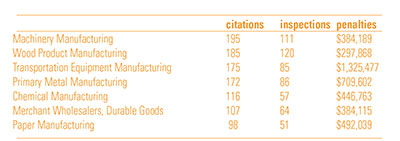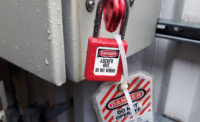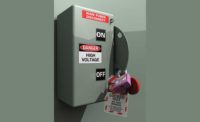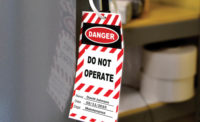OSHA standard 1910.147 The control of hazardous energy (lockout/tagout) covers the servicing and maintenance of machines and equipment in which the unexpected energization or startup of the machines or equipment, or release of stored energy, could harm employees. This standard establishes minimum performance requirements for the control of such hazardous energy.
The lockout/tagout (LOTO) standard was the sixth most frequently cited OSHA standard during the time period October 2013 through September 2014. Federal OSHA issued 3,081 citations and conducted 1,791 inspections related to the LOTO standard during that time period and issued citations totaling $9,734,914.
Companies in the Fabricated Metal Product Manufacturing sector were cited most often, with 555 citations issued during 353 inspections and penalties totaling $905,595. The Food Manufacturing industry was the second-most cited at 253 citations, 130 inspections and $762,451 in fines. Issued the third-highest number of citations, the Plastics and Rubber Products Manufacturing sector was inspected 122 times, had 205 citations and received fines that totaled $564,028. Rounding out the top ten cited industries were:
Who’s at risk? Craft workers, machine operators, and laborers are among the 3 million workers who service equipment and face the greatest risk.
What’s at stake? Compliance with the lockout/tagout standard prevents an estimated 120 fatalities and 50,000 injuries each year. Workers injured on the job from exposure to hazardous energy lose an average of 24 workdays for recuperation.

Employers must act
Here are some of the most critical requirements employers must follow:
• Develop, implement, and enforce an energy control program.
• Use lockout devices for equipment that can be locked out. Tagout devices may be used in lieu of lockout devices only if the tagout program provides employee protection equivalent to that provided through a lockout program.
• Ensure that new or overhauled equipment is capable of being locked out.
• Develop, implement, and enforce an effective tagout program if machines or equipment are not capable of being locked out
• Develop, document, implement, and enforce energy control procedures. [See the note to 29 CFR 1910.147(c)(4)(i) for an exception to the documentation requirements.]
• Use only lockout/tagout devices authorized for the particular equipment or machinery and ensure that they are durable, standardized, and substantial.
• Ensure that lockout/tagout devices identify the individual users.
• Establish a policy that permits only the employee who applied a lockout/tagout device to remove it. [See 29 CFR 1910.147(e)(3) for exception.]
• Inspect energy control procedures at least annually.
• Provide effective training as mandated for all employees covered by the standard.
• Comply with the additional energy control provisions in OSHA standards when machines or equipment must be tested or repositioned, when outside contractors work at the site, in group lockout situations, and during shift or personnel changes.
Source: OSHA, https://www.osha.gov/OshDoc/data_General_Facts/factsheet-lockout-tagout.pdf
Common reasons workers are injured or killed by hazardous energy:
• all hazardous energy sources were not de-energized and controlled
• equipment was not locked out or tagged out after powering off
• did not actually think through the steps of the energy control before starting work
• inadequate or no training
• took shortcuts
Source: Cal/OSHA, http://www.dir.ca.gov/dosh/etools/08-003/P08-00302.pdf




